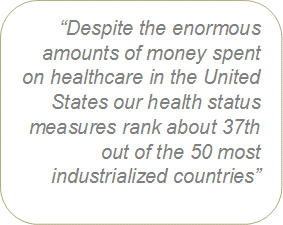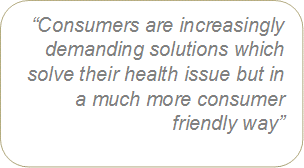POSTED BY Robert McDonald AT 3:57 P.M. Mar 3, 2016
To say that the healthcare industry is under intense pressure to change is an obvious understatement. But in a large and mature industry how do we begin to understand the scope and scale of the change needed? Working with our clients, and a review of the literature has made it clear that there are three broad areas that can provide a framework for change using innovation:
- Rising Cost: The rate of cost growth must be flattened and innovations to do this can run the gamut from new business models to using wearables to anticipate negative medical events before they occur.
- Improved Clinical Outcomes: The efficacy of treatment and positive impact on society must be clearly demonstrated and innovations using Big Data and Artificial Intelligence could identify correlations and potentially negative medical events before they occur. In essence, these innovative combinations could replace today’s medical concierge services.
- Consumer Expectation: The industry must respond to the rising expectations of patients that are increasingly responsible for the cost of care and innovations incorporating software and mobile device applications are an example of how to enhance the patient care experience.
These are clearly complex problems. The question is, how can applied innovation techniques be used to help solve them? When using innovation to help solve complex problems it is important to clearly define the problem being worked on so that potential solutions are more focused. So let’s briefly examine each of these three complex problems in a bit more detail.

Rising Cost
Moving from a volume-ased delivery system to a value-based system, which advances the clinical outcomes and health status of patients, is rapidly accelerating. Despite the enormous amounts of money spent on healthcare in the United States our health status measures rank about 37th out of the 50 most industrialized countries. When we compare ourselves to Australia, Canada, France, Germany, The Netherlands, Norway, Sweden, Switzerland, and the United Kingdom, the average citizen lives six years longer than in the United States. We need to create a delivery system that focuses on creating greater value but at less cost.
Improved Clinical Outcomes
Using evidence-based medicine mined from Big Data tools, is there an opportunity to advance value-based results focused on specific problems? How can these modern tools be used in innovative ways to help to manage patients suffering from the big five of chronic diseases? Can artificial intelligence anticipate the onset of various medical conditions by combining genomic testing and a review of the patient’s and family medical history and records?

Consumer Expectation
The industry simply has not put the patient first from a consumer perspective. When was the last time you had to fill out a form on a clipboard before you received a service or purchased a product from anyone except a healthcare provider? This was tolerated in an era when other options were not available to the patient, but with the rapid growth of accountable care incentives and the greater availability of “Minute Clinic” which are much more consumer friendly, things are changing. Further, as we have seen the shift to first dollar costs being paid by the consumer to meet insurance threshold requirements, consumers are increasingly demanding solutions which solve their health issue but in a much more consumer friendly way. Can moving the site of care from the E.R. to an integrated ambulatory care setting that also incorporates telemedicine help? Are there other innovations that could provide the consumer with a better experience and the ability to achieve better health status?
Innovation and Implementation
So how do innovation tools and processes play in all of this? Most organizations find innovation difficult and are not typically structured or incentivized to innovate. Modern businesses, including the various segments of the healthcare system, are organized to maximize execution against existing economic incentives, but with the rapid migration of incentives focused on creating value over delivering volume, how can innovation help? Innovation requires significant change! Because most people dislike change unless they personally initiate it, implementation of innovative ideas will only happen if there is close communication, coordination and transference of ownership across the vertical silos of the organization. Finally, most organizations have well established operational values that may not encourage innovation and change but instead reward managers for execution against the existing business model. So it is little wonder that with such strong, yet shortsighted economic and cultural conditions fighting against innovation, innovative ideas are relatively easy to create but incredibility difficult to implement.
Recently, Becker’s Hospital Review reported that in the last 18 months over 70 hospitals/health systems have made an executive appointment of a “Chief Innovation Officer.” In light of all the observations made in this white paper how can these executives proceed to achieve success? It seems to us that many of these new innovation managers will struggle to succeed because they lack the process tools necessary to create and implement innovation successfully. The following is a high-level road map of what will need to be done to achieve meaningful success:
Step 1 – What specific problems (3 D’s, please see our recent “Four Pillars” Article) are you are working on and equally important how will you measure success? We know from our work innovation is very hard to accomplish and “breakthrough” innovation is harder. Starting out, healthcare systems would be wise to pick modest innovation goals, which can be quickly and successfully implemented.
Step 2 – Put in place a cross-organization structure that will support the innovation team’s work. What also needs to be in place is a culture where implementing innovation is recognized and rewarded. Coming up with innovative ideas is NOT the greatest challenge we have seen, but rather it is getting innovation successfully implemented. Creating a set of values and support systems for the implementation of innovative ideas is a critical success factor.
Step 3 – The best innovation comes from doing it repeatedly. To do this efficiently you must have in place a repeatable process that supports the innovation team and the creation of ideas.
Step 4 – Would you have thought of attaching a motor to a toothbrush; combining radio frequency with a car key; or putting a camera inside of a cellphone? All three of these breakthrough innovations required the extensive use of “associative thinking” skills and the use of continuous improvement tools. These tools are critical to the success of any innovation team’s creative process. Does your organization widely teach these techniques?
ipCapital Group has worked at the intersection of innovation and IP for the past 15 years. Over the course of those years we have worked on hundreds (900+) of assignments. These assignments have been with clients from many different business sectors. From our work, we have seen many successes on how innovation tools and process can be used to solve complex business problems. But without an established R&D function or years of applying a culture of innovation with the use of these tools and processes, how can these newly appointed health delivery executives benefit from the experience of others?

